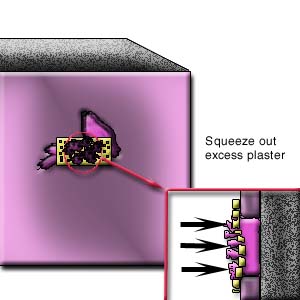Case 1
Navigation
- Introduction
- Causes of Defects
- Good Practices
- Standards
- Maintenance and Diagnostics
- Remedial
- Similar Cases
- References
Remedial
If the rendering has become loose in places and debonding has occurred, a choice must be made between making a repair or removing the whole rendering.
Small areas can be patched and this will often resorted to in view of the commonly experienced difficulty in removing the large patches of the rendering. Patched areas will generally need to be redecorated because of the difficulty of matching the existing rendering.
The procedures for repairing are:

- Check for hollowness of the plaster by knocking them off with the use of a chisel and hammer.

- Remove all loose materials by wire brushing and clean the wall free of all powdery residues, then re-plaster using bonding type plaster.

- Apply the spatterdash coat. If the concrete surface cannot be readily cleaned it may be advisable to apply a bonding agent before re-plastering.
- Application of the undercoat and top coat.
Cracks in plaster must also be repaired before it extends to result in delamination of whole pieces:





Small, narrow cracks can be filled with patching plaster.
- Remove loose plaster and with an icepick or knife, clean the crack so it is wider at the bottom than on the surface. This allows the new plaster to stick better.
- With a brush or damp cloth remove loose plaster dust. If water mixed plaster is used dampen the crack.
- Fill the crack with patching plaster using a criss-cross motion to work it in.
- With the wide putty knife feather the edges of the patch, about 2″ on each side of the crack, so it will
be less visible. - When dry, sand lightly and paint. (Vis. 1)




When the crack is large the wet plaster will not stick (Figure 5a to 5e):
- Clean off all loose plaster. (Vis. 1)
- Fill the crack with plaster and press the perforated patching tape into the wet plaster with a wide putty knife.
- Squeeze out any excess plaster so there will not be a lump in the wall.
- Let it dry, sand lightly and paint.
- A coat of sizing will make the paint stick better and look better